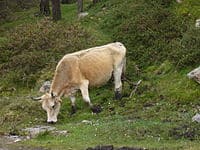Type the name of the breed you're looking for below
[wpdreams_ajaxsearchlite] Don't see the breed your're looking for? Click here and let us know!
Asturian Mountain cattle
| Place of Origin | Spain |
| Origin | The Asturian Mountain breed has been part of the landscape and ecosystem of the east of Asturias for a very long time. This breed belongs to an exclusive bovine group in Spain known as the tronco Cantábrico ('Cantabric trunk') that only includes breeds native to northern Spain, the most numerous of which are the Asturian Valley cattle. The Asturian Mountain is a descendant of the eastern Roxa beef cattle group, historically located in Asturias. Consequently, the breed is sometimes referred to as the RAM (Roxa, Asturian Mountain). This group is distinct from the western Roxa cattle, despite evidence of further variability among animals and areas within the population. For centuries, breeders of the eastern Roxa group in the council of Caso and bordering valleys such as Ponga, selected for higher milk yields aimed at cheese production. This selection made a reputation for the bulls from the council of Caso because of their daughters’ higher milk yield, and changed their farms into sire exporters for the whole of the east of Asturias, playing an important part in the fixation of what nowadays we know as the Asturian Mountain breed. The official census of Asturian Mountain cattle proceeds from the herdbook, which is managed by La Asociación Española de criadores de ganado vacuno selecto de la raza Asturiana de la Montaña (ASEAMO, 'Spanish Association of breeders of selected cattle of the Asturian Mountain breed') since its creation in 1986. |
| Purpose | They are beef cattle, the source of meat labeled with the protected designation "Casín" (after the Asturian town of Caso), and one of three breeds used to produce Casín cheese. |
| Appearance | Medium head with straight profile and big occipital protuberance. Small ears with much hair and slightly prominent eyes with a calm look. Medium neck, thin except in the male, muscled and with a big and discontinuous dewlap, which continues in little and lean withers, well-joined to the slightly muscular back but well-directed, with a slightly saddled back which ends in the hindquarters, narrow in its back diameters and slightly bent, with the birth of the tail often lifted up. Descending chest, deep and spacious breast, and well-proportioned abdomen. Short or medium extremities, beefy on the top with very thin skeletal ratios and small, round and hard hoof. Mammary glands with good development and great quality, well-implanted teats and thin and soft skin. Brown coat, more or less discolored to cream tones, with a white band round the snout and eyes and degraded to creamy colours on the inner part of the extremities, mammary gland, inner part of the thigh and perineal areas. Intensification of the colour with black hairs in the edge of the ears and less intense on the edge of the dewlap. The ends, snout, budding horns, eye circles, tail end, and scrotum circle in males, are black as well as the eyelids and eyelashes. The mucous membranes of the nose, mouth, tongue, anus, and vulva are black or slate black. |
| Horns | Horns born in the elongation of the nape of the neck, shorter and wider in the bulls, horizontal in the base and directed ahead and up with their ends directed to the back and outside. |
| Other Considerations | Commercial output; The basic output is the 7-8 month-old weaned calf for the autumn market. 15 month-old fed calves. 16-18 month-old heifers for production on great demand from extensive farmers of Spanish continental plains, because of their good behavior, rusticity and calving facility (97% of the calvings do not need any help). 2.5-3 year-old bulls, used only for replacement, bred extensively, and kept under specific herd management certified by ASEAMO. |



